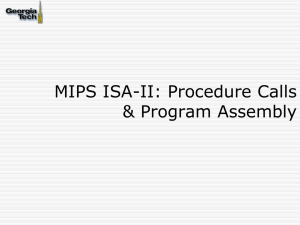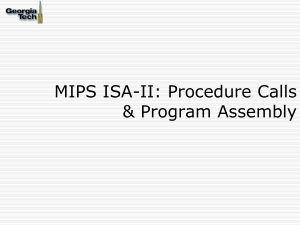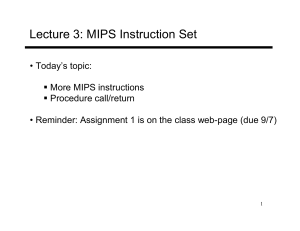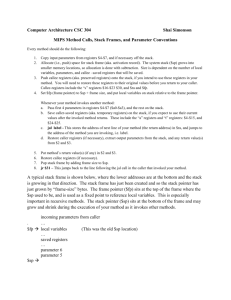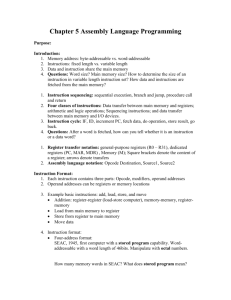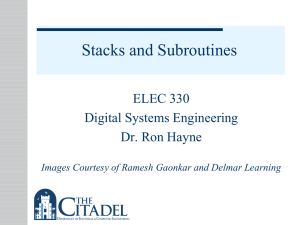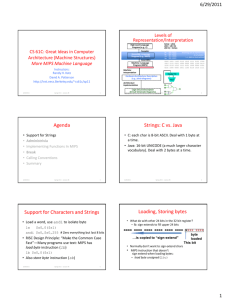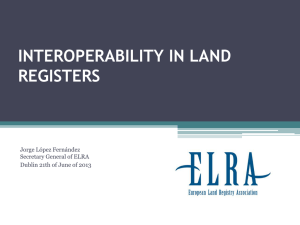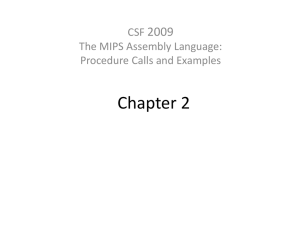03b-mips-procedure
advertisement
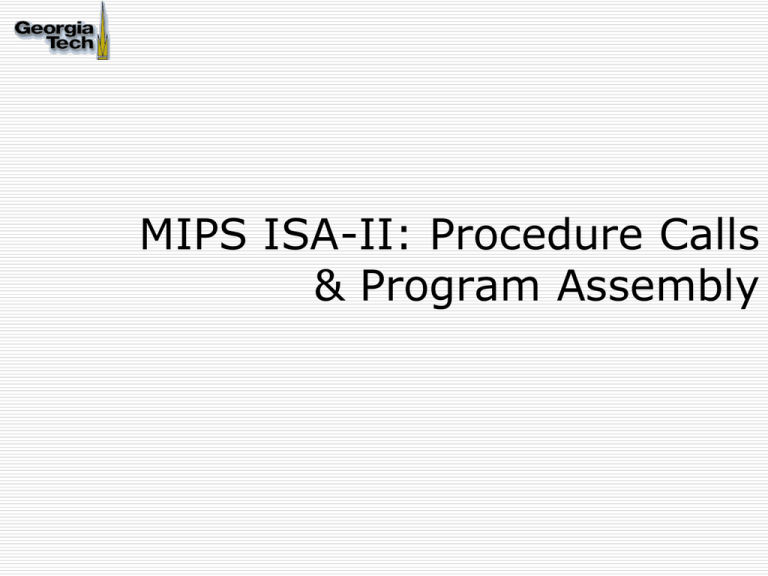
MIPS ISA-II: Procedure Calls
& Program Assembly
Module Outline
Review ISA and understand instruction encodings
• Arithmetic and Logical Instructions
• Review memory organization
• Memory (data movement) instructions
• Control flow instructions
• Procedure/Function calls
• Program assembly, linking, & encoding
(2)
Reading
• Reading 2.8, 2.12
• Appendix B: B1 - B.6
(3)
Procedure Calls
• Basic functionality
Transfer of parameters & control to procedure
Transfer of results & control back to the calling program
Support for nested procedures
• What is so hard about this?
Consider independently compiled code modules
o
o
o
Where are the inputs?
Where should I place the outputs?
Recall: What do you need to know when you write
procedures in C?
(4)
Specifics
• Where do we pass data
Preferably registers make the common case fast
Memory as an overflow area
• Nested procedures
The stack, $fp, $sp and $ra
Saving and restoring machine state
• Set of rules that developers/compilers abide by
Which registers can am I permitted to use with no
consequence?
Caller and callee save conventions for MIPS
(5)
Basic Parameter Passing
arg1:
arg2:
• Register usage
• What about nested
calls?
• What about excess
arguments?
loop:
Normally:
Arguments put in $a0, $a1, $a2, $a3
Values returned in $v0, $v1
func:
exit:
.data
.word 22, 20, 16, 4
.word 33,34,45,8
.text
addi $t0, $0, 4
move $t3, $0
move $t1, $0
move $t2, $0
beq $t0, $0, exit
addi $t0, $t0, -1
lw $a0, arg1($t1)
lw $a1, arg2($t2)
jal func
add $t3, $t3, $v0
addi $t1, $t1, 4
addi $t2, $t2, 4
j loop
sub $v0, $a0, $a1
jr $ra
---
PC
+
$31
PC
$31
(6)
4
Leaf Procedure Example
• C code:
int leaf_example (int g, h, i, j)
{ int f;
f = (g + h) - (i + j);
return f;
}
Arguments g, …, j are passed in $a0, …, $a3
f in $s0 (we need to save $s0 on stack – we will see
why later)
Results are returned in $v0, $v1
argument
registers
$a0
$a1
$a2
$a3
procedure
$v0 result
$v1 registers
(7)
Procedure Call Instructions
• Procedure call: jump and link
jal ProcedureLabel
Address of following instruction put in $ra
Jumps to target address
• Procedure return: jump register
jr $ra
Copies $ra to program counter
Can also be used for computed jumps
o
e.g., for case/switch statements
Example:
(8)
Leaf Procedure Example
• MIPS code:
leaf_example:
addi $sp, $sp, -4
sw
$s0, 0($sp)
add $t0, $a0, $a1
add $t1, $a2, $a3
sub $s0, $t0, $t1
add $v0, $s0, $zero
lw
$s0, 0($sp)
addi $sp, $sp, 4
jr
$ra
Save $s0 on stack
Procedure body
Result
Restore $s0
Return
(9)
Procedure Call Mechanics
High Address
$fp
System Wide Memory Map
$sp
stack
Old Stack Frame
$sp
$fp
dynamic data
arg registers
New Stack
Frame
return address
$gp
Saved registers
PC
static data
text
reserved
$sp
local variables
compiler
ISA
Low Address
HW
$fp is fixed during the procedure.
$sp changes as data is pushed and popped.
Addressing data is easier if offset from $fp is used.
compiler
addressing
(10)
Example of the Stack Frame
arg 1
arg 2
$fp
..
callee
$s0-$s9
saved
registers
caller
$a0-$a3
saved
registers $t0-$t9
local
variables
..
$fp
$sp
$ra
– caller’s
Call Sequence
1. place excess arguments
2. save caller save registers
($a0-$a3, $t0-$t9)
3. jal
4. allocate stack frame
5. save callee save registers
($s0-$s9, $fp, $ra)
6 set frame pointer
Return
1. place function argument in $v0
2. restore callee save registers
3. restore $fp
4. pop frame
5. jr $31
(11)
Policy of Use Conventions
Na m e
$zero
R e g is te r n u m b e r
0
Us a g e
the c o ns ta nt v a lue 0
$v0-$v1
2 -3
v a lue s fo r re s ults a nd e xpre s s io n e v a lua tio n
$a0-$a3
4 -7
a rgume nts
$t0-$t7
8 -1 5
$s0-$s7
1 6 -2 3
saved
$t8-$t9
2 4 -2 5
mo re te mpo ra rie s
te mpo ra rie s
$gp
28
glo ba l po inte r
$sp
29
s ta c k po inte r
$fp
30
fra me po inte r
$ra
31
re turn a ddre s s
(12)
Summary: Register Usage
• $a0 – $a3: arguments (reg’s 4 – 7)
• $v0, $v1: result values (reg’s 2 and 3)
• $t0 – $t9: temporaries
Can be overwritten by callee (so, caller-saved)
• $s0 – $s7: saved
Must be saved/restored by callee
•
•
•
•
$gp: global pointer for static data (reg 28)
$sp: stack pointer (reg 29)
$fp: frame pointer (reg 30)
$ra: return address (reg 31) (caller-saved)
Red names – must be saved by caller because the(13)
callee can change them without restoring.
Non-Leaf Procedures
• Procedures that call other procedures
• For nested call, caller needs to save on the
stack:
Its return address
Any arguments and temporaries needed after the call
• Restore from the stack after the call
(14)
Non-Leaf Procedure Example
• C code:
int fact (int n)
{
if (n < 1) return f;
else return n * fact(n - 1);
}
Argument n in $a0
Result in $v0
(15)
Template for a Procedure
1. Allocate stack frame (decrement stack pointer)
2. Save any registers (callee save registers)
3. Procedure body (remember some arguments
may be on the stack!)
4. Restore registers (callee save registers)
5. Pop stack frame (increment stack pointer)
6. Return (jr $ra)
(16)
Non-Leaf Procedure Example
• MIPS code:
fact:
addi
sw
sw
slti
beq
addi
addi
jr
L1: addi
jal
lw
lw
addi
mul
jr
$sp,
$ra,
$a0,
$t0,
$t0,
$v0,
$sp,
$ra
$a0,
fact
$a0,
$ra,
$sp,
$v0,
$ra
$sp, -8
4($sp)
0($sp)
$a0, 1
$zero, L1
$zero, 1
$sp, 8
$a0, -1
0($sp)
4($sp)
$sp, 8
$a0, $v0
#
#
#
#
adjust stack for 2 items
save return address
save argument
test for n < 1
#
#
#
#
#
#
#
#
#
#
if so, result is 1
pop 2 items from stack
and return
else decrement n
recursive call
restore original n
and return address
pop 2 items from stack
multiply to get result
and return
(17)
Module Outline
Review ISA and understand instruction encodings
• Arithmetic and Logical Instructions
• Review memory organization
• Memory (data movement) instructions
• Control flow instructions
• Procedure/Function calls
• Program assembly, linking, & encoding
(18)
The Complete Picture
Reading: 2.12, B2, B3, B4, B5
C program
compiler
Assembly
assembler
Object module
Object libarary
linker
executable
loader
memory
(19)
The Assembler
• Create a binary encoding of all native
instructions
Translation of all pseudo-instructions
Computation of all branch offsets and jump
addresses
Symbol table for unresolved (library) references
• Create an object file with all pertinent
information
Header (information)
Text segment
Data segment
Relocation information
Example:
Symbol table
(20)
Assembly Process
• One pass vs. two pass assembly
• Effect of fixed vs. variable length instructions
• Time, space and one pass assembly
• Local labels, global labels, external labels and
the symbol table
• Absolute addresses and re-location
(21)
Example
.data
L1:
.word 0x44,22,33,55 # array
.text
.globl main
main:
la $t0, L1
li $t1, 4
add $t2, $t2, $zero
loop:
lw $t3, 0($t0)
add $t2, $t2, $t3
addi $t0, $t0, 4
addi $t1, $t1, -1
bne $t1, $zero, loop
then:
exit:
bgt $t2, $0, then
move $s0, $t2
j exit
move $s1, $t2
li $v0, 10
syscall
What changes when you relocate code?
[00400000] 3c081001
[00400004] 34090004
[00400008] 01405020
[0040000c] 8d0b0000
[00400010] 014b5020
[00400014] 21080004
[00400018] 2129ffff
[0040001c] 1520fffc
[00400020] 000a082a
[00400024] 14200003
[00400028] 000a8021
[0040002c] 0810000d
[00400030] 000a8821
[00400034] 3402000a
[00400038] 0000000c
Assembly
Program
lui $8, 4097 [L1]
ori $9, $0, 4
add $10, $10, $0
lw $11, 0($8)
add $10, $10, $11
addi $8, $8, 4
addi $9, $9, -1
bne $9, $0, -16 [loop-0x0040001c]
slt $1, $0, $10
bne $1, $0, 12 [then-0x00400024]
addu $16, $0, $10
j 0x00400034 [exit]
addu $17, $0, $10
ori $2, $0, 10
syscall
Native
Instructions
Assembled
Binary
(22)
Linker & Loader
• Linker
“Links” independently compiled modules
Determines “real” addresses
Updates the executable file with real addresses
• Loader
As the name implies, loads executable file into
memory, initializes registers, schedules run with OS.
Specifics are operating system dependent
(23)
Linking
Program A
Program B
header
text
Assembly A
static data
Assembly B
reloc
symbol
table
debug
cross reference
labels
• Why do we need independent compilation?
Study: Example on
pg. 143
• What are the issues with respect to independent
compilation?
• references across files
• absolute addresses and relocation
(24)
Example:
# separate file
.text
addi $4, $0, 4
0x20050004
addi $5, $0, 5
0x20050005
jal func_add
000011 & 26-bit addr/4
done
0x0340200a
0x0000000c
# separate file
.text
.globl func_add
func_add: add $2, $4, $5 0x00851020
jr $31
0x03e00008
0x00400000
0x20040004
0x00400004
0x20050005
0x00400008
?
0x0040000c
0x3402000a
0x00400010
0x0000000c
Ans: 0x0c100005
.
0x00400014
0x008551020
0x00400018
0x03e00008
0x0 0
4
0
0
0
0
1
4 32-bit addr
0000 0000 0100 0000 0000 0000 0000 0001 0100 in binary
(25)
0x
0 1
0
0
0
0
0
5
26-bit addr
Object
File A
Linking 2 Object Files
add memory
offset
Arrows indicate relative
addresses that must be
converted to absolute
addresses and inserted
into compiled "text"
(machine code).
Object
File B
X and Y are labels for
locations where variables
are stored.
A and B are labels for
locations where jumps
will go to.
With a virtual memory
system, the Loader will
not have to do any
address translations.
Textbook p.144
(26)
Loading a Program
• Load from image file on disk into memory
1. Read header to determine segment sizes
2. Create virtual address space
3. Copy text and initialized data into memory
o
Or set page table entries so they can be faulted in
4. Set up arguments on stack
5. Initialize registers (including $sp, $fp, $gp)
6. Jump to startup routine
o
o
Copies arguments to $a0, … and calls main
When main returns, do exit syscall
(27)
Dynamic Linking
• Only link/load library procedure when it is
called
Requires procedure code to be relocatable
Avoids image bloat caused by static linking of all
(transitively) referenced libraries
Automatically picks up new library versions
(28)
Lazy Linkage
Indirection table
Stub: Loads routine ID,
Jump to linker/loader
Linker/loader code
Dynamically
mapped code
(29)
The Computing Model Revisited
Register File (Programmer Visible State)
Memory Interface
0x0FFFFFFC
stack
0x00
0x01
0x02
0x03
Processor Internal Buses
0x1F
Dynamic Data
Data segment
(static)
Text Segment
0x0400000
Programmer Invisible State
Program
Counter
Instruction
register
Kernel
registers
Reserved
0xFFFFFFFF
Arithmetic Logic Unit (ALU)
Memory Map
Program Execution and the von Neumann model
(30)
Summary
• Instruction complexity is only one variable
lower instruction count vs. higher CPI / lower clock
rate
• Design Principles:
simplicity favors regularity
smaller is faster
good design demands compromise
make the common case fast
• Instruction set architecture
a very important abstraction indeed!
(31)
Study Guide
•
•
•
Compute number of bytes to encode a SPIM
program
What does it mean for a code segment to be
relocatable?
Identify addresses that need to be modified when a
program is relocated.
•
Given the new start address modify the necessary
addresses
Given the assembly of an independently compiled
procedure, ensure that it follows the MIPS calling
conventions, modifying it if necessary
(32)
Study Guide (cont.)
• Given a SPIM program with nested procedures,
ensure that you know what registers are stored
in the stack as a consequence of a call
• Encode/disassemble jal and jr instructions
• Computation of jal encodings for independently
compiled modules
(33)
Glossary
•
•
•
•
•
•
Argument registers
Caller save registers
Callee save registers
Disassembly
Frame pointer
Independent
compilation
• Labels: local, global,
external
• Linker/loader
• Linking: static vs.
dynamic vs. lazy
•
•
•
•
•
•
•
•
•
•
Native instructions
Nested procedures
Object file
One/two pass
assembly
Procedure invocation
Pseudo instructions
Relocatable code
Stack frame
Stack pointer
Symbol table
(34)
